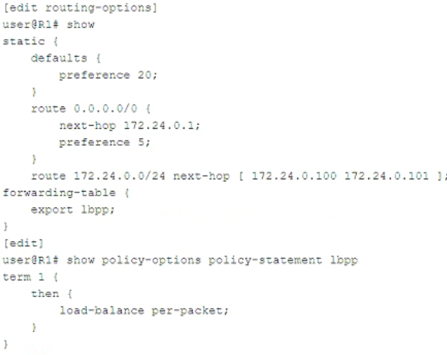Juniper jn0-363 practice test
service provider routing and switching, specialist (jncis-sp)
Last exam update: Mar 26 ,2025
Question 1
Click the Exhibit button.
Referring to the exhibit, you have an established RSVP LSP between R1 and R4 when you experience a link failure between R2 and R3.
Which two statements are correct? (Choose two.)
- A. R2 sends a ResvTear message upstream to R1 signaling the link failure.
- B. R3 sends a PathTear message downstream to R4 signaling the link failure.
- C. R2 sends a PathTear message upstream to R1 signaling the link failure.
- D. R3 sends a ResvTear message downstream to R4 signaling the link failure.
Answer:
ab
Question 2
Which two statements are correct about the behavior of IS-IS metrics? (Choose two.)
- A. Wide metrics enable interfaces to advertise metrics larger than 63.
- B. By default, the metric of an interface is calculated based on the speed of the interface.
- C. Wide metrics enable an interface to advertise different metrics at Level 1 and Level 2.
- D. By default, all physical interfaces have a metric of 10.
Answer:
ad
Question 3
What are two types of SIDs used in segment routing? (Choose two.)
- A. node
- B. link
- C. interface
- D. adjacency
Answer:
ad
Question 4
Which two statements are correct about IS-IS interface metrics? (Choose two.)
- A. By default, an IS-IS interface has a maximum metric value of 1023.
- B. Wide metrics enable IS-IS interface to have a maximum metric value of around 16 million.
- C. Wide metrics enable an IS-IS interface to have a maximum metric value of 1023.
- D. By default, an IS-IS interface has a maximum metric value of 63.
Answer:
ab
Question 5
What are three well-known mandatory BGP attributes? (Choose three.)
- A. MED
- B. origin
- C. community
- D. AS path
- E. next hop
Answer:
bde
Question 6
Interface ge-0/0/0.0 connects your network to your ISP. You want to advertise this interface address as an internal route in OSPF without creating a neighbor with your ISP.
In this scenario, how is this task accomplished?
- A. Remove interface ge-0/0/0.0 from OSPF.
- B. Add ge-0/0/0.0 as a passive interface in OSPF.
- C. Create a generated route for interface ge-0/0/0.0.
- D. Configure a static route for interface ge-0/0/0.0
Answer:
b
Question 7
Which two statements are correct about IS-IS? (Choose two.)
- A. For level 2 adjacencies, the area IDs must be the same.
- B. A level 1 only router can never form an adjacency with a level 2 only router.
- C. A level 1 only router can form an adjacency with a level 2 only router.
- D. For level 2 adjacencies, the area IDs can be different.
Answer:
ac
Question 8
Which two statements are correct about the BGP next-hop attribute value? (Choose two.)
- A. By default, the next-hop value Is changed across EBGP links.
- B. By default, the next-hop value Is not changed across IBGP links.
- C. By default, the next-hop value Is not changed across EBGP links.
- D. By default, the next-hop value is changed across IBGP links.
Answer:
bc
Question 9
Click the Exhibit button.
Which type of load balancing is shown in the exhibit?
- A. network load balancing
- B. elastic load balancing
- C. per-flow load balancing
- D. per-packet load balancing
Answer:
d
Question 10
What is the correct order of BGP attributes for active route selection?
- A. next hop > local preference > AS path > MED > origin
- B. next hop > local preference > AS path > origin > MED
- C. next hop > origin > local preference > AS path > MED
- D. next hop > AS path > local preference > origin > MED
Answer:
b